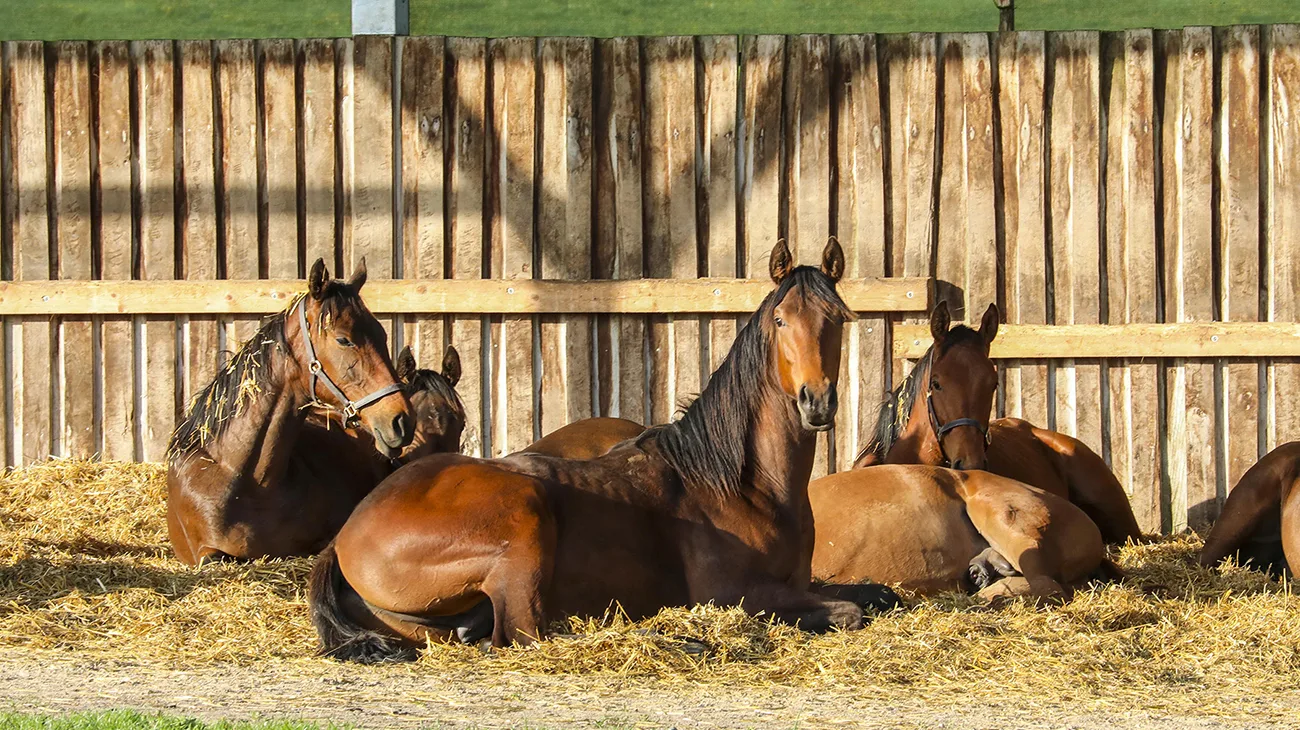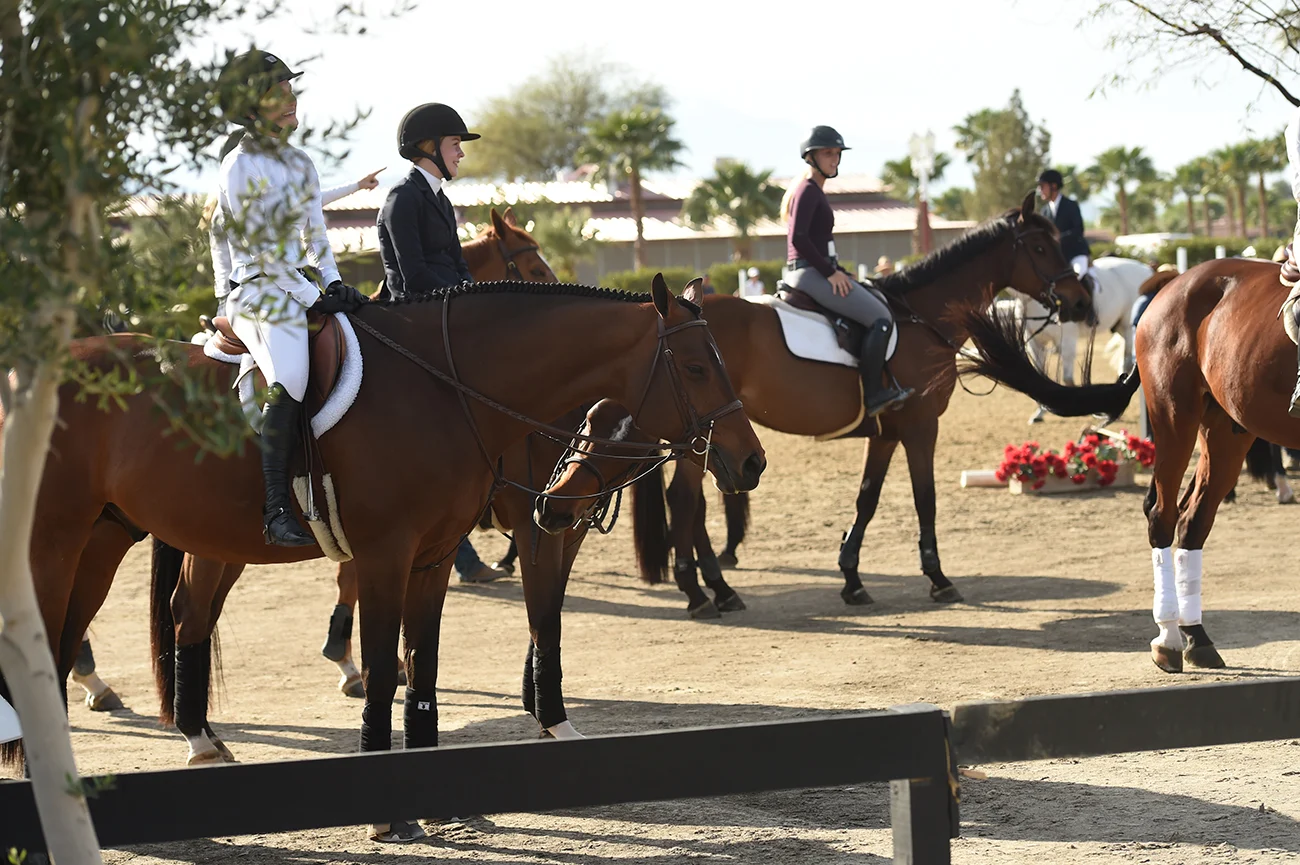When horse people think of welfare for competition horses, they likely think of obvious offenses, like excessive longeing, cruel and illegal bits, or over-jumping. But a new rule passed by the U.S. Equestrian Federation board of directors and enacted in December governs those nighttime hours when the last ring has been dragged and each horse is stalled and fed, and it has show organizers considering the quiet side of competition.
The rule, part of GR1215, restricts light and sound overnight at competitions to promote one very important—and often overlooked—aspect of horse health: sleep.
“Competition management was returning to stabling and, for example, the lights would be on in the middle of the night, or there would be very loud music being played well into after-hours in the middle of the night at the event,” said Katlynn Wilbers, USEF’s director of competition operations and the liaison to the Human and Equine Safety and Welfare Committee, the group that proposed the rule change. “And when it came to enforcement, they didn’t feel like there was a rule for them to really lean into.”

After reviewing the concerns submitted to USEF from competitors and organizers, alongside literature on equine sleep, the Human and Equine Safety and Welfare Committee proposed the rule change. That group, made up of licensed physicians, equine veterinarians and competitors, wanted to offer backing to organizers trying to foster appropriate conditions for restful equine sleep.
Following a comment period, the proposal evolved based on feedback from member groups who were concerned that eliminating lighting would create hazards for those working at show grounds in the dark, like braiders, stall cleaners and emergency veterinarians. The final language of the approved proposal states that, “For six consecutive hours overnight, stabling must have minimal lighting and noise to allow stabled horses to rest adequately.”
“We think that this is an important rule change, and we recognize that change can be difficult, but we definitely have to consider our equine partners in sport and ensure we provide a good life for the horses in competition,” Wilbers said. “If we identify any areas where we can do better, we’ve got to try to do so.”
Linda Greening, DPhil, PGCHE, a researcher who studies equine nocturnal behavior at the University of Hartpury in England, was heartened to see USEF considering the science of horse sleep in its governance.
“USEF is leading the way in lighting, and optimizing the fact that night should be dark, and day should be light—brilliant,” Greening said. “I thought it was just so progressive. For an organization as big as the U.S. Equestrian Federation to go, ‘Wow, we need to stop and think about horse sleep here, because it does play a pivotal role in welfare and performance,’ is so inspiring.”
Why Sleep Is A Welfare Issue
Greening has been researching issues around equine sleep and nocturnal behavior since 2010, including sleep deprivation, rare sleep disorders, and the impact of light on quality of sleep. She says that equine sleep needs to be considered around-the-clock, not just at night—but night does host the majority of a horse’s deepest sleeping hours. For horses stabled overnight at show grounds and training barns where daylight hours are busy—and they may be handwalking, longeing, training or standing ringside for much of the time—that nighttime sleep becomes even more precious.
“The first thing you learn is that horses are polyphasic opportunistic sleepers,” Greening said. “They’ll sleep at different points during the day. The majority will occur during nighttime, but you need to take in how much they’re doing during the day to understand how much they’re doing at night.”
ADVERTISEMENT

The growing research around horse sleep and health has suggested that light plays a role in the quality of the animal’s rest. Deep, restorative sleep is compromised by sound and light, and scientists are still learning more about how those disruptions impact sleep. Leaving lights on, or turning them on and off in the night, has been shown to diminish some of sleep’s most important, restorative effects.
“The research that we have done around leaving the lights on shows that it does impact sleep profiles of horses in stables,” Greening said. “There is recent research that’s come out from a team involving professor Barbara Murphy [of the School of Agriculture and Food Science at University College Dublin], where they have found that turning the lights on various times during the night also has a detrimental effect on gene clock rhythmicity, not even at a behavioral level but [on a] more physiological level, and how that would influence some sleep behavior.
“So to enable horses to have a rest period where you know they’re going to do probably most of their sleeping makes so much sense,” she continued.
Greening notes that it’s not just show grounds that should evaluate their lighting and noise levels to improve standards for sleep. Her own university is no exception; their system aims to meet species-appropriate sleep conditions, balancing research goals with the horses’ wellbeing.
“We, at Hartpury, recognize that our barn is quite intense, because we have students doing duties there during the day,” she said. “So there’s really loud, noisy, intrusive times, and following those times we have two-hour blocks for rest so horses can recover. They know they’re in a routine then, where they can get their rest.”
Greening’s research team is also looking at how technology can allow caretakers to safely navigate dimly lit barns after dark without relying on disruptive lighting. The team found red lights offered a promising alternative to traditional overhead lights.
“We recently looked at a red-white light system, trying to standardize when horses are and aren’t exposed to light, and whether that would affect sleep behavior,” Greening said. “What we found was that working under red light at night was fantastic. It means that you can turn the lights on to do checks, but it won’t affect the horse in any way, shape or form.”
Greening has seen veterinary practices adopting red-light checks, allowing caretakers and veterinarians to safely navigate the barn without disturbing sleeping horses, some- times using a lighting system that transitions from white to red on a timer, or using red-light headlamps during night- time observations.
“The ball is well and truly rolling,” Greening said of the momentum of equine sleep studies and awareness. “I think it’s important because no one was necessarily considering sleep previously, and it’s a massive, overlooked area.”
Equine Sleep As A Community Concern—Not An Individual One
Monica Aleman, DVM, ACVIM, practices and teaches equine veterinary science at the University of California, Davis, where she’s dedicated years of study toward equine sleep. Her obsession has led her to campouts where she’s observed the nocturnal behaviors of wild horses; she’s analyzed the brain waves of horses sleeping to a background of hard rock versus classical music, and she helps her clients solve the mysteries of their horse’s sleep issues—like the owner who gave Aleman a week of surveillance footage of her sleep-deprived horse. (Finally, Aleman spotted the mountain lion that had been prowling around the horse’s field, keeping the mare on high alert.)
Aleman sees the domestication of horses as reason enough that humans should feel responsible for understanding their sleep needs. Caretakers should be aware of and accountable to the factors that influence sleep, to the extent that they’re within human control.
ADVERTISEMENT
“I’m always interested in the welfare of horses, and because we domesticated horses, we changed lots of their natural environmental things, and one of the things that was impacted by domestication was sleep,” Aleman said.
“As a community of horse lovers, let’s be aware that disrupting the sleep of these horses is going to affect their overall health—not only their performance.”
Dr. Monica Aleman
The science of horse sleep continually points to the same fact: Horses are prey animals that need to feel safe before they can get meaningful rest, especially that deep, rapid-eye-movement stage they achieve while lying down. If a horse can’t experience all the cycles of sleep, including REM, they’re at risk for sleep deprivation, which can cause dangerous behaviors, like collapsing.
“Horses are just like us—if we lack any one of the stages of sleep, we’re going to start suffering,” Aleman said.
Many factors impact a horse’s feeling of safety, and unfamiliar environments, as in overnight stabling at show grounds, can create unease. Aleman has found that horses’ sleep preferences and needs are, like humans’, individual. Some prefer sand bedding to shavings, some do well with fewer hours of sleep, and some sleep easily in new environments.
“If horses have time to get adjusted to the environment, they’re more likely to sleep,” she said. “In shows, for example, they’re not familiar with the facility, with the other horses, with the traffic of people. However, [with] big-time show horses, some of them adjust very well to all of those situations and may travel from one place to another; they’re used to that. But there are horses who may not adapt quickly.”
Researchers recognize the particularities of individual animals but have landed on generalizations that can be applied to improve sleep across the board. While owners may have some influence on their horse’s comfort in unfamiliar stabling, like understanding their preferences for bedding, the most influential conditions are set by the wider community, and that’s why it’s so important to have consensus on variables like light and sound levels.
“It’s challenging, because you can do as much as you can for your own horse, but your horse is going to be traveling with other people, other horses, in a different environment,” Aleman said.
“As a community of horse lovers, let’s be aware that disrupting the sleep of these horses is going to affect their overall health—not only their performance,” she continued. “If we all know that, hopefully we can all together say, ‘OK, let’s put the lights off for these horses. Let’s make sure it’s quiet, it’s safe, so we can promote sleep.”
A version of this article originally appeared in the March 2024, issue of The Chronicle of the Horse. You can subscribe and get online access to a digital version and then enjoy a year of The Chronicle of the Horse and our lifestyle publication, Untacked. If you’re just following COTH online, you’re missing so much great unique content. Each print issue of the Chronicle is full of in-depth competition news, fascinating features, probing looks at issues within the sports of hunter/jumper, eventing and dressage, and stunning photography.














